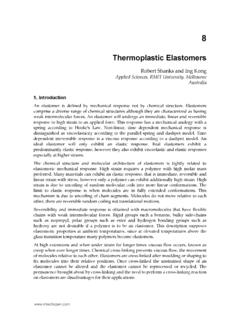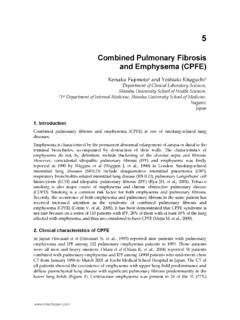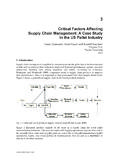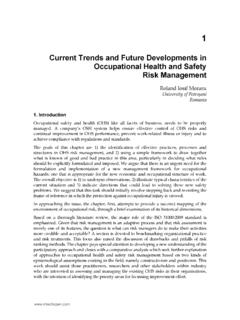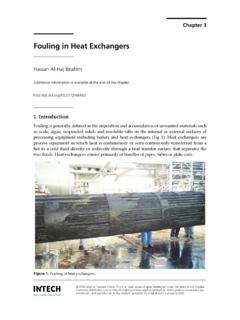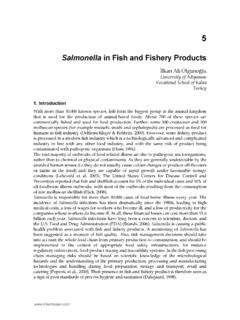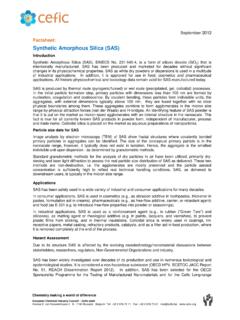Transcription of Silver Nanoparticles - InTech
1 1 Silver Nanoparticles Hassan Korbekandi1 and Siavash Iravani2 1 Genetics and Molecular Biology Department, School of Medicine, Isfahan University of Medical Sciences 2 School of Pharmacy and Pharmaceutical Science, Isfahan University of Medical Sciences Iran 1. Introduction Nanotechnology is an important field of modern research dealing with design, synthesis, and manipulation of particles structure ranging from approximately 1-100 nm. Tremendous growth in this emerging technology has opened novel fundamental and applied frontiers, including the synthesis of nanoscale materials and exploration or utilization of their exotic physicochemical and optoelectronic properties. Nanotechnology is rapidly gaining importance in a number of areas such as health care, cosmetics, food and feed, environmental health, mechanics, optics, biomedical sciences, chemical industries, electronics, space industries, drug-gene delivery, energy science, optoelectronics, catalysis, reorography, single electron transistors, light emitters, nonlinear optical devices, and photo-electrochemical applications (Colvin et al.)
2 1994; Wang and Herron 1991; Schmid 1992; Hoffman et al. 1992; Hamilton and Baetzold 1979; Mansur et al. 1995). Silver Nanoparticles are of interest because of the unique properties ( , size and shape depending optical, electrical, and magnetic properties) which can be incorporated into antimicrobial applications, biosensor materials, composite fibers, cryogenic superconducting materials, cosmetic products, and electronic components. Several physical and chemical methods have been used for synthesizing and stabilizing Silver Nanoparticles (Senapati 2005; Klaus-Joerger et al. 2001). The most popular chemical approaches, including chemical reduction using a variety of organic and inorganic reducing agents, electrochemical techniques, physicochemical reduction, and radiolysis are widely used for the synthesis of Silver Nanoparticles . Recently, nanoparticle synthesis is among the most interesting scientific areas of inquiry, and there is growing attention to produce Nanoparticles using environmentally friendly methods (green chemistry).
3 Green synthesis approaches include mixed-valence polyoxometalates, polysaccharides, Tollens, biological, and irradiation method which have advantages over conventional methods involving chemical agents associated with environmental toxicity. This chapter presents an overview of Silver nanoparticle preparation by physical, chemical, and green synthesis approaches. The aim of this chapter is, therefore, to reflect on the current state and future prospects, especially the potentials and limitations of the above mentioned techniques for industries. Moreover, we discuss the applications of Silver Nanoparticles and their incorporation into other materials, the mechanistic aspects of the antimicrobial effects of Silver Nanoparticles . The Delivery of Nanoparticles 4 2. Synthesis of Silver Nanoparticles Physical approaches Most important physical approaches include evaporation-condensation and laser ablation.
4 Various metal Nanoparticles such as Silver , gold, lead sulfide, cadmium sulfide, and fullerene have previously been synthesized using the evaporation-condensation method. The absence of solvent contamination in the prepared thin films and the uniformity of Nanoparticles distribution are the advantages of physical approaches in comparison with chemical processes. Physical synthesis of Silver Nanoparticles using a tube furnace at atmospheric pressure has some disadvantages, for example, tube furnace occupies a large space, consumes a great amount of energy while raising the environmental temperature around the source material, and requires a great deal of time to achieve thermal stability. Moreover, a typical tube furnace requires power consumption of more than several kilowatts and a preheating time of several tens of minutes to reach a stable operating temperature (Kruis et al.)
5 2000; Magnusson et al. 1999). It was demonstrated that Silver Nanoparticles could be synthesized via a small ceramic heater with a local heating source (Jung et al. 2006). The evaporated vapor can cool at a suitable rapid rate, because the temperature gradient in the vicinity of the heater surface is very steep in comparison with that of a tube furnace. This makes possible the formation of small Nanoparticles in high concentration. This physical method can be useful as a nanoparticle generator for long-term experiments for inhalation toxicity studies, and as a calibration device for nanoparticle measurement equipment (Jung et al. 2006). Silver Nanoparticles could be synthesized by laser ablation of metallic bulk materials in solution (Mafune et al. 2000; Mafune et al. 2001; Kabashin and Meunier 2003; Sylvestre et al. 2004; Dolgaev et al. 2002). The ablation efficiency and the characteristics of produced nano- Silver particles depend upon many factors such as the wavelength of the laser impinging the metallic target, the duration of the laser pulses (in the femto-, pico- and nanosecond regime), the laser fluence, the ablation time duration and the effective liquid medium, with or without the presence of surfactants (Kim et al.
6 2005; Link et al. 2000; Tarasenko et al. 2006; Kawasaki and Nishimura 2006). One important advantage of laser ablation technique compared to other methods for production of metal colloids is the absence of chemical reagents in solutions. Therefore, pure and uncontaminated metal colloids for further applications can be prepared by this technique (Tsuji et al. 2002). Silver nanospheroids (20-50 nm) were prepared by laser ablation in water with femtosecond laser pulses at 800 nm (Tsuji et al. 2003). The formation efficiency and the size of colloidal particles were compared with those of colloidal particles prepared by nanosecond laser pulses. The results revealed the formation efficiency for femtosecond pulses was significantly lower than that for nanosecond pulses. The size of colloids prepared by femtosecond pulses were less dispersed than that of colloids prepared by nanosecond pulses. Furthermore, it was found that the ablation efficiency for femtosecond ablation in water was lower than that in air, while, in the case of nanosecond pulses, the ablation efficiency was similar in both water and air.
7 Chemical approaches The most common approach for synthesis of Silver Nanoparticles is chemical reduction by organic and inorganic reducing agents. In general, different reducing agents such as sodium Silver Nanoparticles 5 citrate, ascorbate, sodium borohydride (NaBH4), elemental hydrogen, polyol process, Tollens reagent, N, N-dimethylformamide (DMF), and poly (ethylene glycol)-block copolymers are used for reduction of Silver ions (Ag+) in aqueous or non-aqueous solutions. The aforementioned reducing agents reduce Silver ions (Ag+) and lead to the formation of metallic Silver (Ag0), which is followed by agglomeration into oligomeric clusters. These clusters eventually lead to formation of metallic colloidal Silver particles (Wiley et al. 2005; Evanoff and Chumanov 2004; Merga et al. 2007). It is important to use protective agents to stabilize dispersive Nanoparticles during the course of metal nanoparticle preparation, and protect the Nanoparticles that can be absorbed on or bind onto nanoparticle surfaces, avoiding their agglomeration (Oliveira et al.)
8 2005). The presence of surfactants comprising functionalities ( , thiols, amines, acids, and alcohols) for interactions with particle surfaces can stabilize particle growth, and protect particles from sedimentation, agglomeration, or losing their surface properties. Polymeric compounds such as poly(vinyl alcohol), poly(vinylpyrrolidone), poly(ethylene glycol), poly(methacrylic acid), and polymethylmethacrylate have been reported to be effective protective agents to stabilize Nanoparticles . In one study, Oliveira et al. (Oliveira et al. 2005) prepared dodecanethiol-capped Silver Nanoparticles , based on Brust procedure (Brust and Kiely 2002), based on a phase transfer of an Au3+ complex from aqueous to organic phase in a two-phase liquid-liquid system, followed by a reduction with sodium borohydride in the presence of dodecanethiol as a stabilizing agent, binding onto the Nanoparticles surfaces, thereby avoiding their aggregation and making them soluble in certain solvents.
9 They reported that small changes in synthetic factors lead to dramatic modifications in nanoparticle structure, average size, size distribution width, stability and self-assembly patterns. Zhang et al. (2008) used a hyperbranched poly(methylene bisacrylamide aminoethyl piperazine) with terminal dimethylamine groups (HPAMAM-N(CH3)2) to produce colloids of Silver . The amide moieties, piperazine rings, tertiary amine groups and the hyper-branched structure in HPAMAM-N(CH3)2 are important to its effective stabilizing and reducing abilities. Uniform and size controllable Silver Nanoparticles can be synthesized using micro-emulsion techniques. The Nanoparticles preparation in two-phase aqueous organic systems is based on the initial spatial separation of reactants (metal precursor and reducing agent) in two immiscible phases. The interface between the two liquids and the intensity of inter-phase transport between two phases, which is mediated by a quaternary alkyl-ammonium salt, affect the rate of interactions between metal precursors and reducing agents.
10 Metal clusters formed at the interface are stabilized, due to their surface being coated with stabilizer molecules occurring in the non-polar aqueous medium, and transferred to the organic medium by the inter-phase transporter (Krutyakov et al. 2008). One of the major disadvantages of this method is the use of highly deleterious organic solvents. Thus large amounts of surfactant and organic solvent must be separated and removed from the final product. For instance, Zhang et al. (2007) used dodecane as an oily phase (a low deleterious and even nontoxic solvent), but there was no need to separate the prepared Silver solution from the reaction mixture. On other hand, colloidal Nanoparticles prepared in nonaqueous media for conductive inks are well-dispersed in a low vapor pressure organic solvent, to readily wet the surface of the polymeric substrate without any aggregation.


